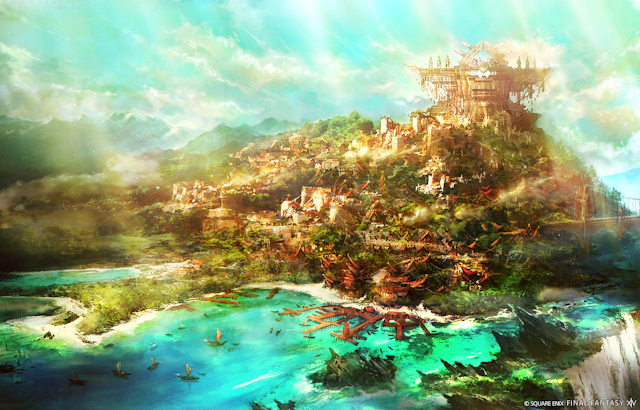The popular online role-playing game Final Fantasy XIV will be taking its players to the “New World” when its fifth content expansion, Dawntrail, is released next summer. More than a passing reference to the age of European exploration, it is set on a new continent, known as Tural, which draws historical and cultural inspiration from pre-Columbian Latin America and civilisations such as the Aztec, Inca and Maya.
The game’s producer, Naoki Yoshida, announced the expansion at the end of July 2023 during an official fan festival. He explained that the story will begin with playable characters being invited to the New World. There they will oversee a contest over the throne of Tuliyollal – a major city in the region.
The journey to Tural is portrayed in the announcement trailer as a well-earned, exotic vacation for players after the apocalyptic events of the game’s last expansion, Endwalker. While some Latin American players are excited to see their historical culture represented in the game, other players have expressed concern about the colonial role their player character might play in the story.
One fan responded by analysing the way in which they claim indigenous culture has already been poorly represented in the game. They claim that the game’s producers, Square-Enix, have “a really awful track record” that “doesn’t bode well for Dawntrail”.
These concerns about the way in which Latin American history and culture will be reflected in the game are understandable. While video games are an exciting medium through which to reflect Latin American history and culture, the region’s past is commonly represented through tomb raiding ancient civilisations and colonisation.
However, as a historian of empire, I believe that Final Fantasy XIV has already demonstrated over the past ten years of its development that video games can present nuanced interpretations of imperialism.
Final Fantasy’s track record
The release of the newest game in the long-running series in June hasn’t helped the brand’s image – when Final Fantasy XVI hit the shelves, Yoshida was criticised for the game’s lack of racial diversity. When asked about the absence of non-white characters, he stated that this was because the game world was based on medieval Europe. Whether intentional or not, this white washing of European history ignores the continent’s racially diverse past – a misconception historians are already struggling to counter.
So, will Dawntrail’s narrative and setting parrot colonial tropes of the Americas? While it’s still too early to tell, Final Fantasy XIV’s story has a track record of taking the historical realities of imperialism seriously, despite its fantasy setting.
Like many other games in the series, the plot of Final Fantasy XIV centres around a struggle against the oppressive expansion of an empire. While hardly a post-colonial critique, the game sheds light on imperial relationships and themes that reflect a more nuanced understanding of the history of empire.

The Garlean Empire is presented as a threat to the player at the beginning of the game’s narrative. This is due to its military expansion into Eorzea, the region in which players begin the game. The way in which the Garlean Empire justifies its imperialism is strikingly similar to historical empires.
Although they are unable to utilise magic, Garleans are a race of humans that are born with a “third eye” that increases their spatial recognition. This racial trait is used by Garleans to differentiate themselves from the other “savages” of the world. This allows the empire to frame its expansion as a civilising duty. This accurately reflects the historical rhetoric of imperial policy makers, who adhered to the “white man’s burden” – the idea that the white race had a moral duty to civilise the non-white peoples of the world.
Changes for Stormblood
The game’s second expansion, Stormblood, draws attention to the ways in which local elites have sometimes collaborated with imperial rulers. This is an aspect of imperial history that historians such as Tanja Bührer are keen to analyse. It demonstrates that imperial relationships are not simply static interactions between colonisers and the colonised. Power and agency is fluid on both sides.
Fordola Lupis is an antagonist in the story who serves the Garlean Empire after her home nation, Ala Mhigo, is annexed. Players learn that she brutally suppresses Ala Mhigan resistance efforts because her father was killed for advocating collaboration with the empire to ensure the nation’s survival. Despite her loyalty to the empire, Fordola is still considered a “savage” in the imperial hierarchy. This reflects the limitations that local elites have faced when cooperating with imperial powers in real life.

The game’s last expansion, Endwalker, presented the perspectives of imperial citizens in the metropole. When the Garlean Empire finally collapses, players encounter Garlean citizens and gain insights into the ways in which the empire’s expansion influenced their civilian lives. It’s important because it recognises that empires not only subjugate and affect other peoples, but that they also transform society at home.
If Dawntrail ends up propagating colonial tropes, then it ought to be criticised. But Final Fantasy XIV’s narrative demonstrates that video games can present nuanced interpretations of imperialism.
The game’s localisation lead (who oversees the game’s translation from Japanese and helps build its lore), Kathryn Cwynar, offered players hope on the second day of the fan festival when she explained that: “when we do draw on real life cultures and languages, we want to develop an understanding and a respect for those cultures”. She said that the team was aware of its past failings and promised that “we are really working on it” for Dawntrail.

Looking for something good? Cut through the noise with a carefully curated selection of the latest releases, live events and exhibitions, straight to your inbox every fortnight, on Fridays. Sign up here.

